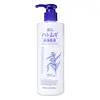What's inside
What's inside
 Key Ingredients
Key Ingredients

 Benefits
Benefits

 Concerns
Concerns

 Ingredients Side-by-side
Ingredients Side-by-side

Dipotassium Glycyrrhizate
HumectantGlycerin
HumectantMyristic Acid
CleansingStearic Acid
CleansingPEG-7 Glyceryl Cocoate
EmulsifyingPotassium Hydroxide
BufferingLauric Acid
CleansingPalmitic Acid
EmollientGlyceryl Isostearate
EmollientGlyceryl Stearate Se
EmulsifyingDiallyldimethyl Ammonium Chloride
Glycol Distearate
EmollientCetearyl Alcohol
EmollientCoix Lacryma-Jobi Ma-Yuen Seed Extract
Skin ConditioningButylene Glycol
HumectantAloe Barbadensis Leaf Extract
EmollientPrunus Persica Leaf Extract
EmollientAlcohol Denat.
AntimicrobialSodium Hyaluronate
HumectantCetyl-Pg Hydroxyethyl Decanamide
Skin ConditioningCamellia Oleifera Leaf Extract
AstringentEDTA
Citric Acid
BufferingSodium Paraben
PreservativeParfum
MaskingDipotassium Glycyrrhizate, Glycerin, Myristic Acid, Stearic Acid, PEG-7 Glyceryl Cocoate, Potassium Hydroxide, Lauric Acid, Palmitic Acid, Glyceryl Isostearate, Glyceryl Stearate Se, Diallyldimethyl Ammonium Chloride, Glycol Distearate, Cetearyl Alcohol, Coix Lacryma-Jobi Ma-Yuen Seed Extract, Butylene Glycol, Aloe Barbadensis Leaf Extract, Prunus Persica Leaf Extract, Alcohol Denat., Sodium Hyaluronate, Cetyl-Pg Hydroxyethyl Decanamide, Camellia Oleifera Leaf Extract, EDTA, Citric Acid, Sodium Paraben, Parfum
Water
Skin ConditioningGlycerin
HumectantParaffinum Liquidum
EmollientSqualane
EmollientButylene Glycol
HumectantPetrolatum
EmollientCoix Lacryma-Jobi Ma-Yuen Seed Extract
Skin ConditioningCeramide Ng
Skin ConditioningButyrospermum Parkii Butter
Skin ConditioningPrunus Persica Leaf Extract
EmollientBetaine
HumectantSodium Hyaluronate
HumectantSteareth-6
EmulsifyingSodium Hydroxide
BufferingCarbomer
Emulsion StabilisingTetrasodium EDTA
Methylparaben
PreservativeEthylparaben
PreservativeWater, Glycerin, Paraffinum Liquidum, Squalane, Butylene Glycol, Petrolatum, Coix Lacryma-Jobi Ma-Yuen Seed Extract, Ceramide Ng, Butyrospermum Parkii Butter, Prunus Persica Leaf Extract, Betaine, Sodium Hyaluronate, Steareth-6, Sodium Hydroxide, Carbomer, Tetrasodium EDTA, Methylparaben, Ethylparaben
Ingredients Explained
These ingredients are found in both products.
Ingredients higher up in an ingredient list are typically present in a larger amount.
Butylene Glycol (or BG) is used within cosmetic products for a few different reasons:
Overall, Butylene Glycol is a safe and well-rounded ingredient that works well with other ingredients.
Though this ingredient works well with most skin types, some people with sensitive skin may experience a reaction such as allergic rashes, closed comedones, or itchiness.
Learn more about Butylene GlycolYou might know this plant as Job's Tears or Chinese pearl barley. It is a grain native to Southeast Asia.
This ingredient has skin conditioning properties. Emerging studies show the grain to exhibit antioxidant and anti-inflammation properties as well. (With one study finding this ingredient to be effective at blocking melanin when skin is exposed to UV).
Job's tears is rich in nutrients, such as thiamine, riboflavin, niacin and ascorbic acid.
You can also find great antioxidants such as ferulic acid, caffeic acid.
To top if off, ceramides are also present in this grain.
Learn more about Coix Lacryma-Jobi Ma-Yuen Seed ExtractGlycerin is already naturally found in your skin. It helps moisturize and protect your skin.
A study from 2016 found glycerin to be more effective as a humectant than AHAs and hyaluronic acid.
As a humectant, it helps the skin stay hydrated by pulling moisture to your skin. The low molecular weight of glycerin allows it to pull moisture into the deeper layers of your skin.
Hydrated skin improves your skin barrier; Your skin barrier helps protect against irritants and bacteria.
Glycerin has also been found to have antimicrobial and antiviral properties. Due to these properties, glycerin is often used in wound and burn treatments.
In cosmetics, glycerin is usually derived from plants such as soybean or palm. However, it can also be sourced from animals, such as tallow or animal fat.
This ingredient is organic, colorless, odorless, and non-toxic.
Glycerin is the name for this ingredient in American English. British English uses Glycerol/Glycerine.
Learn more about GlycerinPrunus Persica Leaf Extract comes from the leaves of the peach tree.
Peach leaves contain antioxidants such as ferulic acid.
As an emollient, peach leaves help soften and moisturize your skin. Emollients create a barrier on the skin to prevent moisture from escaping. This helps keep your skin hydrated.
Learn more about Prunus Persica Leaf ExtractSodium Hyaluronate is hyaluronic acid's salt form. It is commonly derived from the sodium salt of hyaluronic acid.
Like hyaluronic acid, it is great at holding water and acts as a humectant. This makes it a great skin hydrating ingredient.
Sodium Hyaluronate is naturally occurring in our bodies and is mostly found in eye fluid and joints.
These are some other common types of Hyaluronic Acid:
Learn more about Sodium Hyaluronate